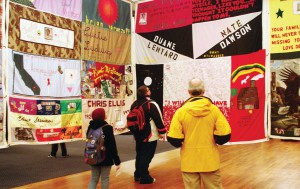Stitched together by AIDS
Memorial Quilt will tour UW-Eau Claire

December 2, 2014
Next week the Ojibwe Ballroom will be adorned with sections of a 54-ton community art project started 30 years ago.
The AIDS Memorial Quilt was born from the AIDS crisis in the ‘80s and ‘90s and consists of over 48,000 3-by-6-foot patches memorializing those who died due to AIDS. Each quilt section features 8 patches and is twelve feet square. It will be on disaplay 9 a.m. to 9 p.m. Monday-Thursday in the Ojibwe Ballroom.
“Each panel represents the person who died in the way that the loved ones remember them,” Chris Jorgenson, the director of the Women’s and LGBTQ Resource Center, said.
In 1985, Cleve Jones was organizing a candlelight march to honor two gay San Francisco men involved in government who had been assassinated. After learning that 1,000 San Franciscans had died due to AIDS, he asked the marchers to write names of lost friends and family members on placards. At the end of the march, Jones and other marchers taped the placards onto the San Francisco Federal Building and the image of a patchwork quilt came alive.
“It became a world-wide symbol of the AIDS crisis,” Jorgenson said, “in particular, to the United States, the government’s unwillingness to actually address the issue because it was impacting what they thought was only the gay community.”
World AIDS Day was Dec. 1, but Jorgenson said next week was the closest time the university could get The Quilt for four days in a row.
“I think it is really important to raise awareness about AIDS,” Dylan Vorass, the director of communications for PRIDE, said. “It still makes a very big impact on our society.”
Those viewing The Quilt should plan to be moved, Jorgenson said. The touring memorial personalizes AIDS in ways that statistics can’t.
With 32 million people living with AIDS worldwide, Jorgenson said The Quilt should serve as a reminder because AIDS is becoming a silent killer again.
“It absolutely has the ability to start conversations where they need to be started,” he said.
The Quilt also toured UW-Eau Claire four years ago. This year, when requesting sections, Jorgenson was able to specifically request some that have direct connections to the community. The panels represent 28 countries and all genders, races and ages.
“We believe the national narratives that we hear a lot,” Jorgenson said. “People think of HIV and AIDS and they think of gay men, and that still holds on really tight. But the science has told us that AIDS does not discriminate. People do, but HIV and AIDS isn’t picking out certain demographics, it’s taking advantage of certain behavior.”


